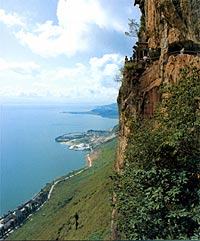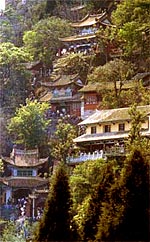|
 The Western Hills The Western Hills lie among the
Biji Mountain chain to the west of Kunming. From the
east or north banks of the Dianchi Lake, you can see
the Western Hills, looking just like a young girl lying
with her face to the sky and her long hair drifting into
the water of the lake. The local people call her the
"Sleeping Beauty." The folk legend says that she is
dreaming of her lover's return and her tears have formed
the vast Dianchi Lake. The Western Hills The Western Hills lie among the
Biji Mountain chain to the west of Kunming. From the
east or north banks of the Dianchi Lake, you can see
the Western Hills, looking just like a young girl lying
with her face to the sky and her long hair drifting into
the water of the lake. The local people call her the
"Sleeping Beauty." The folk legend says that she is
dreaming of her lover's return and her tears have formed
the vast Dianchi Lake.
The Western Hills scenic area stretches from the
wooded Huating Temple to the Longmen (Dragon Gate) along
the steep cliffs. Clouds and mist often hide the mountain
sides, with their giant firs and pines and many ancient
temples. The Huating Temple, the Taihua Temple, Sanqingge and
Longmen were
all built around the Ming and Qing dynasties. In the Taihua
Mountains, old
roads lead to places surrounded by trees, ideal places to shed
one' s
earthly worries and thoughts. The Huating Temple is famous for its
colorful statues that combine styles of Buddhism and Taoism. The
solemnity
of Buddhism and the freedom of Taoism blend into one. The Taihua
Temple,
often shrouded in mist, is 1.5 kilometres from the Huating Temple
on the
main peak of the Taihua Mountains. This tranquil and isolated
temple gives
one a feeling of heavenly peace. The main halls are built along
the
rising slopes. Covered corridors connect each pavilion and
mansion. With
its ancient trees, perfumed orchids, camellias, osmanthus and plum
trees,
the Taihua Temple is noted for its peace, tranquility and elegance.
In the
cliffs under Luohan Peak, in the Western Hills, are the Longmen
Grottoes,
with a stone gate leading to the Datiange chamber. 2,300 metres
above sea
level, these are the largest Taoist grottoes in Yunnan. It took 72
years
to build these grottoes during the Qing Dynasty, from the 46th
year of
Emperor Qianlong's rule(1782)to the 3rd year of Emperor Xianfeng's
rule (1854). The project was undertaken by stone craftsmen living
at the foot of the Western Hills. It is said that the workers
could get a measure of rice for each measure of stone, poor
payment for such hard and dangerous work.
Datiange (Mansion of Heaven) is a stone chamber carved out of
the
cliffs and is regarded as the finest of the Longmen Grottoes. The
relief
carving on the walls, the gods, the sacrificial table and the
candlesticks
are all sculpted following the
 original shape of the rocks. The Kuixing
(God of literature and exams) in the center has one foot on a huge
turtle.
Holding a dipper and a brush, he turns back to look into the blue
sky
above the cliffs. Yet his brush has no point. It is said that the
stone
carver broke the brush point by accident and spoiled the work of
decades.
He dropped his knife and threw himself over the cliffs. Standing
on the
Longmen, the lake is vast and the sky is endless. In the morning,
it is
an ideal place to greet the rising sun. In the evening, one can
admire
the sparkling lights of downtown Kunming. These scenes all make
one feel
like a god about to rise to the heavens. original shape of the rocks. The Kuixing
(God of literature and exams) in the center has one foot on a huge
turtle.
Holding a dipper and a brush, he turns back to look into the blue
sky
above the cliffs. Yet his brush has no point. It is said that the
stone
carver broke the brush point by accident and spoiled the work of
decades.
He dropped his knife and threw himself over the cliffs. Standing
on the
Longmen, the lake is vast and the sky is endless. In the morning,
it is
an ideal place to greet the rising sun. In the evening, one can
admire
the sparkling lights of downtown Kunming. These scenes all make
one feel
like a god about to rise to the heavens.
The 3rd of March is a festive time in the Western Hills. It is
the
best time for Kunming residents to climb the mountains and look
into the
distance, to admire the spring flowers and appreciate the feeling
of new
life.
|